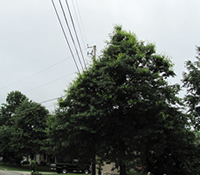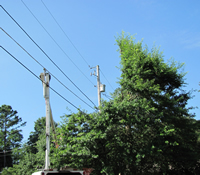Lateral Pruning
KUB contract crews use the lateral pruning method recommended by the Arbor Day Foundation and other tree-care organizations. Lateral pruning refers to cutting tree branches back to the lateral or “parent” limb.
Crews make cuts at the nearest lateral branch growing away from the power lines, which may be beyond the minimum safety maintenance zone. If there is no lateral, crews may have to cut the branch back to the trunk of the tree itself.


Lateral pruning is healthier for the tree because it helps ensure that the tree’s natural defenses can seal the pruning cut and prevent the spread of disease or decay. Cutting a branch in the middle of its length—and not back to the lateral—means that dozens of fast-growing sprouts shoot out vertically from the cut. That opens up multiple avenues for disease and insects to enter the tree. It also means that repeat pruning will be required more often.
Lateral pruning also strives to train the tree to grow away from electric wires. This is because branches that are growing toward the lines are cut back to laterals that grow away from the power lines. This is how lateral pruning helps redirect growth away from the lines.
Some tree services previously used the “topping” or “rounding over” method of pruning. Some customers still prefer that practice because it seems more visually appealing. The method is no longer considered healthy for the tree, however, because cutting branches in the middle causes sprouts and opens up the tree to disease and insect infestation.